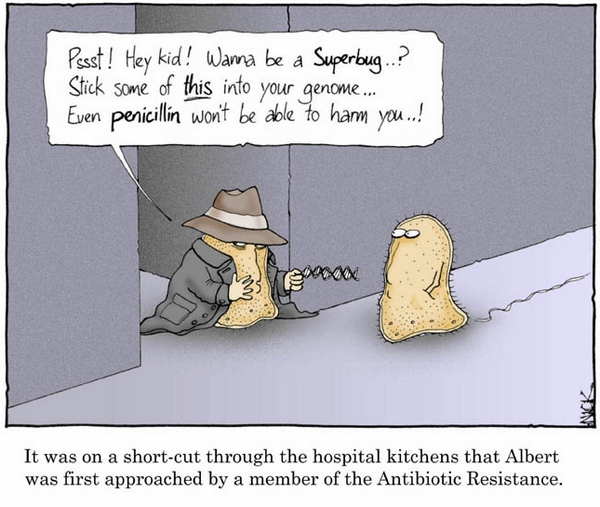Do you realize that almost all living organisms produce substances that kill bacteria? It is nature’s own way of producing antibiotics. In the plant kingdom, plants produce what are known as phytoalexins which have antimicrobial activity. Bacteria produce bacteriophages that kill other bacteria. In the human body substances known as peptides also have antimicrobial activity.
Pharmaceutical companies like to exploit, use, these phytoalexins (antioxidant polyphenolitics) because of their interaction with various proteins in the human body. This activity makes and excellent base to build a pharmaceutical drug from. For instance, the drug metformin was developed from a plant phytoalexin and the statin drugs were derived from fungus and their ability to interfere with a human enzyme that controls the synthesis of cholesterol.
of their interaction with various proteins in the human body. This activity makes and excellent base to build a pharmaceutical drug from. For instance, the drug metformin was developed from a plant phytoalexin and the statin drugs were derived from fungus and their ability to interfere with a human enzyme that controls the synthesis of cholesterol.
There are herbs and spices that are used today as supplements and in food to destroy pathogens. For instance garlic, ginger, thyme, and cinnamon, to name a few, have been used for millennia as medicinal microbials. Today, many essential oils, which have become immensely popular, exploit nature’s natural antimicrobial properties.
Most of today’s modern antibiotics target bacteria enzymes and disrupt a critical part in the bacteria’s life cycle. However, bacteria are automatically geared to mutate and that mutation process leads to antibiotic resistance.
How do bacteria turn into antibiotic resistance superbugs?
In the average bacteria there are about one thousand genes that reside on a single chromosome. Every time a bacterium replicates, several mutations, or mistakes, take place. These mutations can alter the target area on the bacteria that is targeted by the antibiotic. This new area then produces a new enzyme or a slightly changed enzyme that may or may not be affected by the existing antibiotic. If the change varies enough, antibiotic resistance ensues and that particular antibiotic becomes useless against the new strain of bacteria.
Really there is nothing ‘super’ about the modified bacteria. It is doing what it normally does throughout the course of its life cycle. When bacteria replicate, mutations can occur in an enormous amount of locations throughout the bacteria’s DNA. Antibiotic resistant mutations are rare, estimated at less than one in a million, but, like super rabbits, bacteria can reproduce a lot in a given day. A million bacteria can grow from one single bacterium in one day. Because of these odds, in a given batch of bacteria, let’s say in your gut, there are always a few antibiotic resistant bacteria hanging around.
How do antibiotics hasten this process?
As we just read, there are always a few antibiotic resistant bacteria in your gut. Normally they are kept in check by the ‘good’ guys and other mechanisms. When you take an antibiotic it kills only those bacteria that are susceptible to its disruption properties, leaving the antibiotic resistant ones free to replicate at greater speed. So antibiotics mimic a selection process that allows the bacteria that are resistant the freedom to replicate.
In addition, bacteria engage in a kind of bacteria ‘sex’ where bacteria can exchange genetic material between one other. This occurs by a process called bacterial conjugation. During bacterial conjugation genetic material is exchanged by cell to cell contact. One place that this occurs is in the biofilm that lines your gut.
Ok, so what about pharmaceuticals?
Remember at the beginning of this article we talked about how pharmaceuticals exploit the naturally  occurring substances of the plant world called phytoalexins? And that these substances all have microbial properties? So, most of our pharmaceuticals today start out as some form of phytoalexin and they exhibit antibiotic properties that select for certain bacteria. This is an unintended consequence, but still a consequence, of most pharmaceutical use. So, many of our popular drugs in use today such as anti-diabetics, NSAIDS, anti-depressants, and statins all exert a definite antibiotic effect in the body and especially your gut on certain bacteria. Theoretically, the use of pharmaceuticals, even those that are not designated antibiotics, can exert negative influences on your body’s microbiome and contribute to antibiotic resistance.
occurring substances of the plant world called phytoalexins? And that these substances all have microbial properties? So, most of our pharmaceuticals today start out as some form of phytoalexin and they exhibit antibiotic properties that select for certain bacteria. This is an unintended consequence, but still a consequence, of most pharmaceutical use. So, many of our popular drugs in use today such as anti-diabetics, NSAIDS, anti-depressants, and statins all exert a definite antibiotic effect in the body and especially your gut on certain bacteria. Theoretically, the use of pharmaceuticals, even those that are not designated antibiotics, can exert negative influences on your body’s microbiome and contribute to antibiotic resistance.
According to Dr. Art Ayers “Pharmaceuticals are just repurposed natural antibiotics.”






Leave A Comment